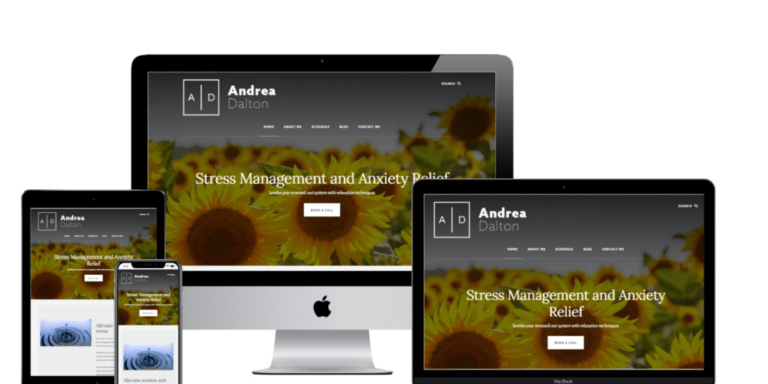Done well, a website can help to grow your private practice.
A therapist website is a powerful marketing tool that can help you reach out to potential clients, normalise seeing a therapist or coach, and increase referrals to your practice.
You’d never dream of working with a client in a cluttered office, similarly, it’s important to think about the impression you are creating with your website design.
With that in mind, here are 9 tips for creating an effective therapy site:
1. Create a compelling headline
The first thing visitors see is the home page. Your headline is the first line of any piece of content you publish. It tells the reader what your practice is about. Click here to access a free tool to improve your headlines.
- Define your niche: your headline should make it clear who you help.
- The goal is to help the visitors to see why they should continue reading. Your marketing message should include the type of client you work with.
- Underneath, include a clear call to action to take the first step. This could be to book a call or a link to your services pages.
2. Choose a simple logo
Your logo should be simple and have clean lines so that it displays well in different sizes. Your logo design needs to represent your counselling or therapy practice.
Try to create a logo that looks well in black and white as well as colour as you may need to use it in a variety of formats for your marketing, such as on flyers.
Your logo should not be the focal point on your homepage, keep it simple and an appropriate size so that it isn’t distracting.
3. Ease of Navigation
A counselling website must have clear navigation. Make sure that users can get the information they need without having to search for it.
Users often don’t take the time to visit every page on a website, so if your website is hard to navigate, a prospective client will be less likely to return to your site.
4. Include white space in your design
Make sure your website has a professional look by using white space to keep your design clean and uncluttered.
- Avoid animations or fancy graphics. Keep it simple and clean.
- White space makes the on your page easier to read. In addition, it helps break up the elements on the page.
- The text on the website should be easy to read and any paragraphs should be no more than two or three sentences.
- Add photos to create visual interest and break up your text.
5. Create a site map
Creating a site map is an important aspect of a successful therapist’s website. If you don’t have one, your site will probably suffer from a lack of usability.
If you are just starting a new website, you should think about what you are offering and how the site map can reflect that.
6. Give clients a sense of who you are
In other words, you need to have a photo or video of yourself to help prospective clients to decide if they might like to work with you.
Ideally, you would have a professional headshot or video displayed on your homepage.
Showing clients what you look like and how you sound can go a long way in helping clients to get a sense of you as a therapist.
Tell them what kind of services you provide in your private practice, what kind of professional training you have, list any relevant CPD and why they should choose you.
Remember to avoid psychobabble, check that your writing is clear. Hemingway app is a free tool you can use to refine your writing. You can use it when you create any marketing materials for your private practice.
Choosing images for marketing your private practice
For a therapist, it’s always a challenge to find suitable photos. There are many websites that offer stock photos, which are usually generic pictures.
Be very careful about using images of people as often stock imagery is not inclusive or reflective of your clients.
Where to start when choosing images
- The process starts with finding inspiration. Browse sites that are related to your practice or that have services that match yours. Then, it’s time to get to work.
- Include photos of your office or therapy rooms
- High-quality images lend a professional air to the overall design and enhance your brand as a therapist
As an example, I have a client who specialises in work-related stress.
The first thing that jumps to mind when you think about stress is a picture of a stressed person.
Instead, when marketing your business choose brand imagery that offers hope.
Choose images that have more of a positive uplifting tone.
If your therapy practice is centred around helping clients overcome anxiety and stress, then images that communicate a sense of relaxation are going to be appealing and symbolise transformation.
7. Make it easy to get in touch
Having a contact form is an essential part of any therapy website. While some people like to fill out lengthy surveys and questionnaires to help them get to know their potential clients better, this isn’t always the best approach.
Be mindful of data privacy and remember that having a long form can significantly reduce the likelihood of someone contacting you.
- The form should clearly state what the purpose of the form is, what information the client will be asked to provide, what information you’ll be using for verification purposes, and whether or not the client will receive any additional information after they submit their contact form.
- Streamline your contact forms and display contact details on every page.
- Make sure you have a professional email address that matches your domain name. E. g. hello[at]mytherapywebsite. com, not mary[at]gmail. com.
- Be clear about the medium you’ll use to reply to any enquiries and make sure to check your inbox regularly.
Why are therapy websites so important?
People are actively searching for therapists. A good therapist website can help you to attract more clients.
The reason why therapy websites are so effective is that you have the ability to reach potential clients who are genuinely interested in the services you offer in your private practice.
8. Get found online
SEO can make it easier for new clients to find you online. When someone searches for a therapist using Google, your business needs to show up in the search results.
SEO marketing tips:
- If you work from a centre, add a map to your website.
- If you only work online, make sure that you are listed on relevant therapist directories
- Create a page for each service you offer in your practice
- Use an SSL certificate for security reasons (if you’re not sure about this, contact your web host)
Blogging and SEO
It’s very important to create an article or post regularly for your therapist website. Content is king, and without it, you’re not going to be able to provide useful information to your visitors. If you’d like to learn to blog using SEO, please visit my Blogging for Business SEO course.
Writing articles can help to raise awareness about your private practice and reach those who might be ready to learn more about how therapy can help.
Marie O’Sullivan
You can use a variety of strategies to ensure that your writing is engaging and appealing to your target audience.
- Check the design on a range of devices, including mobile
- Create posts that are relevant to the visitor. If they’re too complicated, your visitors won’t be interested.
- Use visuals in your design. Pictures, videos, infographics, and other forms of media can be effective at providing your readers with useful information.
9. Make sure it loads quickly
If your website is slow to load this is a big problem for users as they are more likely to click away if your content doesn’t load within a few seconds.
So, make sure that your website is built to be quick, and that you’re doing everything you can to improve your website’s performance.
View this post on how to speed up your WordPress website.
I recommend investing in a premium theme as these are built to perform well and load quickly.
Most of us get caught up in the excitement of creating a website, and we forget to plan ahead. That’s why I’ve put together this list of things to think about before creating a counselling or coaching website. I hope you found it helpful.

Marie O’Sullivan
MIACP, B.A. Business and Languages, B.Sc. Counselling and Psychotherapy, M.Sc. Child and Adolescent Counselling, PGCE, Dip Personal, Leadership and Executive Coaching, Dip IT, Dip Web Design, SEO Specialist Certification.
Marie O’Sullivan is a Counsellor and Web Designer who loves helping other therapists and coaches to connect with more clients and impact more lives.

